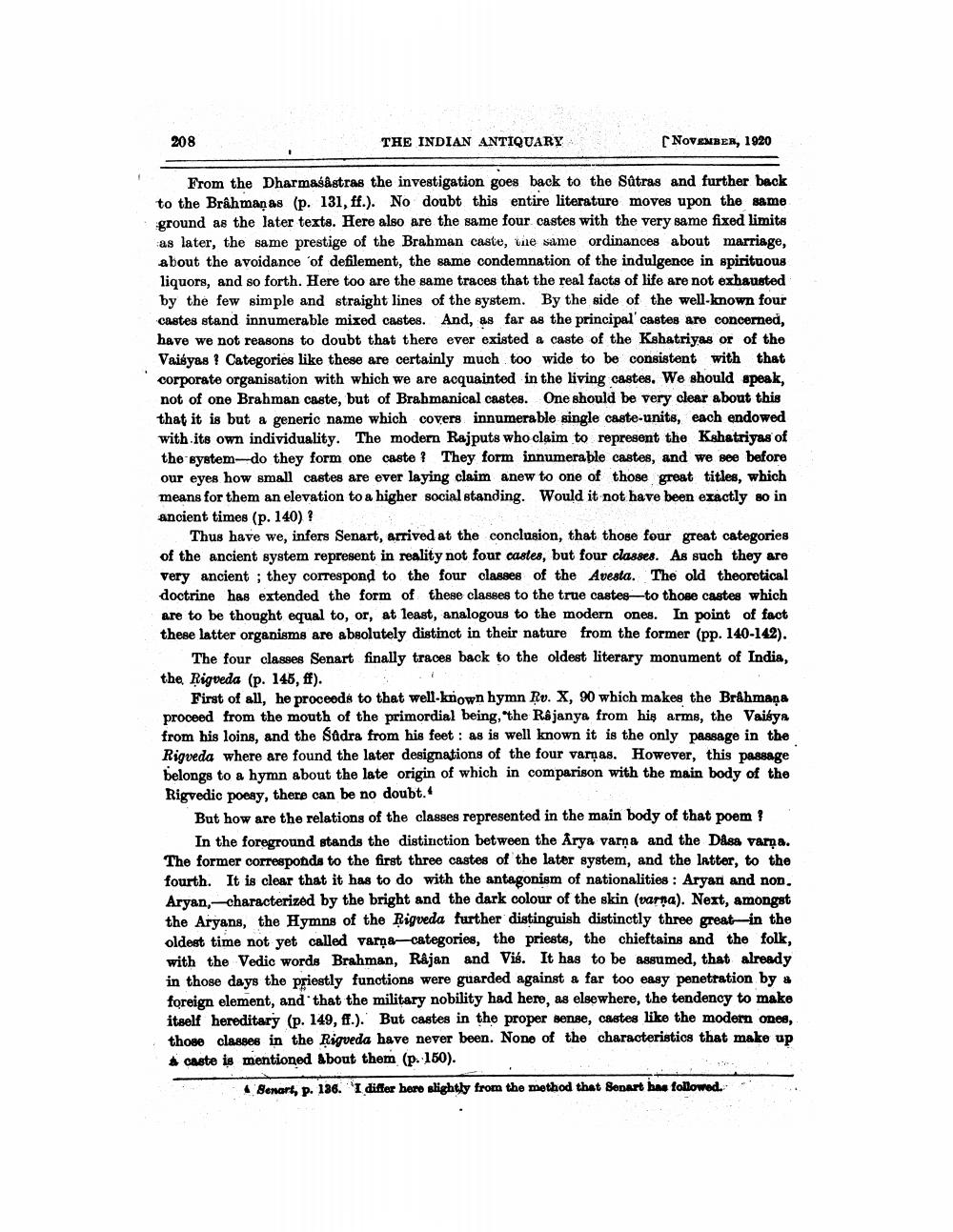________________
208
THE INDIAN ANTIQUARY
NOVEMBER, 1920
From the Dharmasastras the investigation goes back to the Sûtras and further back to the Brahmaņas (p. 131, ff.). No doubt this entire literature moves upon the same ground as the later texts. Here also are the same four castes with the very same fixed limits as later, the same prestige of the Brahman caste, the same ordinances about marriage, about the avoidance of defilement, the same condemnation of the indulgence in spirituous liquors, and so forth. Here too are the same traces that the real facts of life are not exhausted by the few simple and straight lines of the system. By the side of the well-known four castes stand innumerable mixed castes. And, as far as the principal castes are concerned, have we not reasons to doubt that there ever existed a caste of the Kshatriyas or of the Vaisyas ? Categories like these are certainly much too wide to be consistent with that corporate organisation with which we are acquainted in the living castes. We should speak, not of one Brahman caste, but of Brahmanical castes. One should be very clear about this that it is but a generic name which covers innumerable single caste-units, each endowed with its own individuality. The modern Rajputs who claim to represent the Kshatriyas of the system-do they form one caste ? They form innumerable castes, and we see before our eyes how small castes are ever laying claim anew to one of those great titles, which means for them an elevation to a higher social standing. Would it not have been exactly so in ancient times (p. 140) ?
Thus have we, infers Senart, arrived at the conclusion, that those four great categories of the ancient system represent in reality not four castes, but four classes. As such they are Very ancient ; they correspond to the four classes of the Avesta. The old theoretical doctrine has extended the form of these classes to the true castes to those castes which are to be thought equal to, or, at least, analogous to the modern ones. In point of fact these latter organisms are absolutely distinct in their nature from the former (pp. 140-142).
The four classes Senart finally traces back to the oldest literary monument of India, the Rigveda (p. 145, ff).
First of all, he proceods to that well-known hymn Rv. X, 90 which makes the Brahmaņa proceed from the mouth of the primordial being, the Rajanya from his arms, the Vaisya from his loins, and the Sadra from his feet: as is well known it is the only passage in the Rigveda where are found the later designations of the four varnas. However, this passage belongs to a hymn about the late origin of which in comparison with the main body of the Rigvedic poesy, there can be no doubt.
But how are the relations of the classes represented in the main body of that poem
In the foreground stands the distinction between the Arya varna and the Dass varna. The former corresponds to the first three castes of the later system, and the latter, to the fourth. It is clear that it has to do with the antagonism of nationalities : Aryan and non. Aryan-characterized by the bright and the dark colour of the skin (varna). Next, amongst the Aryans, the Hymns of the Rigveda further distinguish distinctly three great in the oldest time not yet called varņa-categories, the prieste, the chieftains and the folk, with the Vedic words Brahman, Rajan and Vis. It has to be assumed, that already in those days the priestly functions were guarded against a far too easy penetration by # foreign element, and that the military nobility had here, as elsewhere, the tendency to make itself hereditary (p. 149, ff.). But castes in the proper sense, castes like the modern ones, those classes in the Rigveda have never been. None of the characteristics that make up caste is mentioned about them (p. 150).
Benart, p. 136. 'I differ here slightly from the method that Separt has followed.




